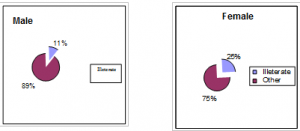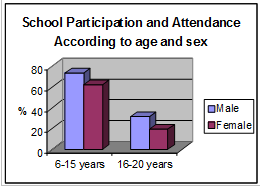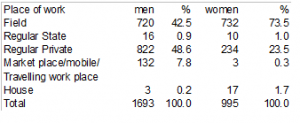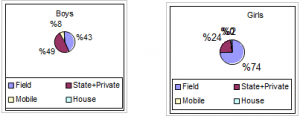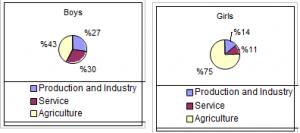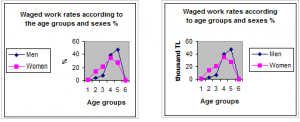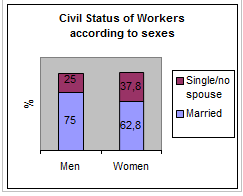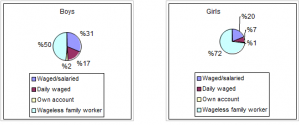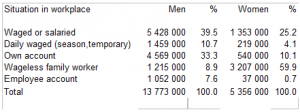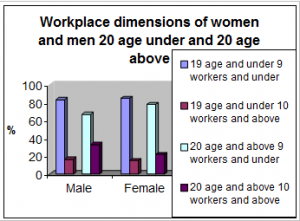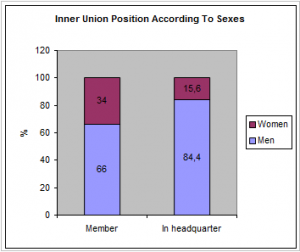Gender Inequity As A Source of Child Abuse and Neglect
Oya Fisek, Yasemin Günay-Balcı, A. Gürhan Fisek
As “labour” and “work” are very important sources feeding inequality in sex roles on the other hand are important sources causing child abuse and neglect.
Abuse and neglect sourcing from gender pity that exist in society independent from age. It only is tried to be lightened or pass over through an active manner. In this study of ours we tried to show the gender inequality seen in “working life” as the sources of child abuse and neglect.
While proving this we benefited from the inquiries, focus group work and face to face interviews and applications as such of Fisek Institute Science and Action Foundation for Child Labour.
I
INEQUALITIES
INEQUALITY No.1.: When we look at literacy rates and school attendance rates in our country, we see that girls remain in lower levels compared to boys. Is this inequality a source of abuse and neglect? YES.
According to Population and Health Survey of Hacettepe Institute of Population Studies while the rate of illeterate men is 10.7 percentthis rate is 25.4 percentin women. In fundemental education the participation of 6-15 ages boys to school is 74.0 the girls is 62.6 percent. As age increases the difference between boys and girls increases also. In 16-20 ages these rates are 31.6 for men and 19.6 for girls.
Graphics I: The Sex Distribution of Illeteracy According To Age and Sex
Graphics 2: Schooling Rate according to Age and Sex
When school quitting reasons of women in 15-24 years who attended previously to school and departed in research date looked the most important quitting reason from school among the ones who couldn’t finish primary school is that their families haven’t given permission for attendance (36%), the most important reason of secondary school quitting is failing in examinations (36%).8% of these women indicated their marriage as school quitting reason.
The inquiry results of Fisek Institute Science and Action Foundation for Child Labour applied to 102 young girls in Ankara face to face are in this direction and 60.8% of the young girls who cut relations with school under 18 years of age have primary or under educational level. One third of young girls (34 persons) while leaving school with their own wishes two third observed to cut relation with school other than their own wishes. 55.9% of the girls who cut relations with school want to turn back to school.
INEQUALITY No.2: More pressure is applied on girls than boys and they are forced for house axis work. This causes their social isolation. Is this fact a source of abuse and neglect? YES.
Lets have a look at the properties of work places according to sexes in 12-19 age group and 20 age and above.
Table 1
The distribuution of work place properties according to sexes in 12-19 age group.
Graphics 3: The distribution of work place properties according to sexes in 12-19 age group
Table 2
The work place properties distribution according to sexes in 20 ages and above
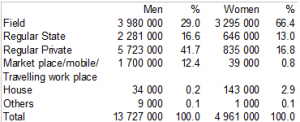
(* “Others”group hasn’t been considered in test)
While in 12-19 age group the rate of working boys in regular state and private work places is 49.5%, in girls this rate is 24.5%. Above 20 age these rates are consequintely 58.3% and 29.8%. Girls working in agricultural works has much more rate compared to boys, most of these work in their own family establishments.
The participation of boys in social life and girls consciously keeping away from it drives reaction and this indicates itself in various ways in inquiries:
- The rate of complaining girls from sex discrimination is 28%.
- The rate of girls who wants to be a boy -in another coming to world-, is 23%.
- The rate of girls who want to born as a bird, flower,animal -in another coming to world-, since these are seen as symbols of freedom is 26%.
- The rate who doesn’t even want to live is not few (3 %).
- They carry the anger of not living the freedom of their brothers’ like to meet with their friends after workplace exit.
At the inquiries done, when asked how they evaluated free times, after work times, the rate of girls who also work at the weekends and also at home was more than the boys. If in future life they get married what will happen to them is final from today. To finish by working first in workplace than in house.
Despite all hardness and uglineess the work life is seen a part of being saved from social isolation by girls and wanted. The ones who let wait in house for a marriage are more unlucky.
INEQUALITY No. 3 : The evaluations done by State Statistics Institute indicate that 4 millions of children under 18 years of age work. Boys form the important part of the working ones in industry and services sector; and girls form the important part of the family workers in the agricultural sector. Is this inequality or inbalance a source of abuse and neglect? YES.
Table 3.
According to SSI data in 1999 the distribution according to sex and profession in 12-19 age group
X²: 284.59 p<0.001
Graphics 4 : The distribution according to sex and profession in 12-19 age group
Table 4 According to SSI data in 1999 in 12-19 age group distribution according to sex and economic activity branches
Graphics 5 : 12-19 age group distribution according to sex and economic activity branches
Professional groups and economic activity branches according to sexes when examined, a four third majority of women while working in agriculture men seen working in production – industry and service sector.
INEQUALITY No. 4 : The researches done when sent to the working life of girls it is clear that while job being chosen wage level is a primary criterium. Boys’ criterium is their gaining a profession. At the work choice of girls not gaining a profession but gaining more wage to be primarily preferred. Is this inequality a source of abuse and neglect? YES.
At a study done by Fisek Institute in Denizli and supported by ILO for three years it is searched whether the children directed to work differed according to sexes.
Table 5 : Distribution of reasons of work of children according to sexes

* (Two reasons coming forth has a share in “all” reasons of work: 80%)
As seen, boys and girls, while being directed by their families to work, important statistical interests raise. While men expected to gain professions girls only expected to gain money.
We meet to the same fact at SSI 1994 Employment and Wage Structure Inquiry results.
Table 6
Men and women wage work rates and weekly work equivalent hourly wages
Graphic 6 : Waged work rates according to age groups and sexes
While 3.4% of working boys is “19 years of age and under” as a waged-workers, this rate is 15.2% in women. In further years the situation turns in favour of men. Same situation occurs in hourly wage according to ages. Tables and graphics clearly shows that women have been let work for wages in young ages and quit working life in further ages and while they are kept in unqualified labour position in parallel to this fact they get lower wages.
Hacettepe Institute of Population Studies made a population and health survey and according to this research more than half of the working girls in 15-19 ages don’t decide on how to spend their own gain (52.2%).
Fisek Institutite implied an inquiry to young girls in Denizli and Ankara. According to the results of the inquiry there is a harmony with this research. 51 % of working girls in Denizli 40 % in Ankara (46.0 %)expressed that they handled all the money to their families. Four thirds of the working girls give all or part of their salary to their families.
INEQUALITY No. 5: Again the researches done, indicate that both the families and the girls aging in working life gets away from working life when get married. Not to work after marriage is specific for girls. This attitude is not seen in men. Is this fact a new abuse and neglect? YES.
While working women rate is more than working men rate till 25 age after 25 age this turns vice versa. After 35 years of age this difference gets clearer.At the head of the work departure reasons for women comes child birth and getting married. Difference according to ages in working men and women rates is an indicator of this fact.
Table 7
Distribution of civil status of all workers according to their sexes
(1999 year House Population Work Power Inquiry Results of SSI)
Graphic 7 : Civil Status of workers according to sexes
The married employee in women is lower statistically meaningfully. Fisek Institute indicated that 102 young girls interviewed face to face said that 63.7 % (65 persons) will work after marriage, 18.6% (19 persons) will work through the permission Of the spouse, according to work situation,child position etc, 17.7 (18 persons) said that they will not work at all.
24 out of 84 young girls who said they will work after marriage or according to conditions 29.6%(25 persons) said they will not easily obey when not permitted to work by their husbands remaining 71.4%(60 persons).
At the Denizli study of Fisek Institutite the evaluation of young girls who said they will be ‘house wife’ in accordance with age slices gave interesting results. When stays in working life girls want to be their house’s wife more. This shows us how difficult conditions there are in workplaces and working life such as pressure, violence.
Table 8
Distribution According To Age Of The ‘House Wife’ Expectation of Working Girls Departing Their Works

(*The share of this reason as future expectation in all working reasons:36%)
Again in Denizli study, the sex distribution of working children who are in expectation ‘to establish own business’ indicate differences. 88% of the boys, 23% of the girls want to establish their own business.
Table 9
Distribution according to sexes of the expectation of ‘establishing own bussiness’ of working children

* The share of this expectatiion among the reasons,dreams is 36%.
INEQUALITY No. 6 : The women who are married and have children after quitting the work and after years passed by in difference with the same aged men have less knowledge, few experiences of work and they are merely unqualified labour objects. Therefore they can find less waged and unqualified positions compared to men. Is this fact a new abuse and neglect? YES.
Table 10
The situations of 12-19 age employees according to their sexes in work places.
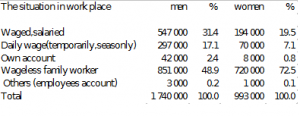
* “Others” group has not taken into account in test.
Four third of 12-19 age women work as wageless family worker. This reminds us that girls are preferred as family workers and not sent to school or professional works.
Graphic 8 : The situations of 12-19 age employees according to their sexes in work places
Table 11
Workplace positions of 20 age and above according to their sexes
While age increases in men and wageless family workmanship decreases the amount of own account work increased importantly. The situation difference of 12-19 age boys and girls in workplaces reflects in further ages and increases thus.
Table 12
According to the sexes of 12-19 age workers the workplace dimensions.
Table 13
The workplace dimensions off 20 age and above in accordance the sexes
Graphics 9
Workplace dimensions of women and men 20 age under and 20 age above
While girls working rate in the workplaces more than 10 persons in 12-19 group is more than boys, 20 age and above this situation statistically turns vice versa in reverse position.
In summary in young ages the roles for young girls discriminating behaviour and attitude towards girls reaches and continues in adultery and old ages too. Young girls when get married mostly work at agricultural sector, in small dimensioned workplaces and work as wageless family workers.
According to the Hacettepe Institute of Population Studies one out of each four working women has a child under 6 years of age and 34% of these take care of their children themselves. Their relatives and the elder sister of the child are respectively most important babysitters in 36% and 11% rates, despite their regions it has been clearly seen that father or brother has no roles at baby sitting.
INEQUALITY No.7 : Researches done show that the girls have no knowledge about their rights. Does this lack of knowledge about rights and freedoms increase the abuse and neglect? Yes. Ignorance brings solutionless. Causes a wish for being borned as a bird or a boy or even not to be alive at all. This is being solutionless. However girls are not in conscious that they can change their present situations and future positions.
An inquiry we have done in most simple subjects in workplaces in accordance with health and safety measures indicated that girls’ level of knowledge is 27.7 out of 100. In boys this figure is 22.4. These points are quiet low because questions cover very basic subjects and not knowing these questions shows that there isn’t a single hope for an effort for solution.
Really misinformation or disinformation brings a reactionless manner. When asked to girls what they would do if a measure which must necessarily be taken wasn’t fulfilled they answered and said they sit and wait quitely. If we count the replies saying they keep away f rom dangerous places the rate of having no reaction reaches to 68%. In boys this rate is 77%.
INEQUALITY No.8 : Women keeps a distance to the processes of getting organised for protecting the rights and developing them. When looked to trade unions and their women memberships and headquarter positions in trade unions the women participation is quiet low. Is to be kept away from organised right protection processes increase the abuse and neglect of girls? YES.
According to April 1999 data 9.7% of the total employees in public and private sector have unionized (956 292 workers). While 62.7% of members work in manufacturing industry, the total unionized is 4% working in agriculture, metalurgy and energy branches. This is one of the reasons why women has low unionized.
The share of women workers among union membership is 12.9%. Among total members in public sector the woman rate is 7.9% in private sector this rate is 16.1%.
In workers section women member workers have a rate of 6% in Türk-İş 12% in DISK, in state sector in KESK rate is 30%. One third of members of KESK and Eğitim-Sen is women but in union headquarter places this figure is very low.
Table 14
Total member number in KESK and Eğitim -Sen and distribution of those who are in headquarter
While more than one third in state is women in headquarter places this number is one sixth.
On the other hand, when the qualities of the places of work remembered, it will clearly be understood that these workplaces are the ones without unions and places without wages. This is an indicator for women how they are disorganised.
Graphic 10
Inner Union Position According To Sexes
II
ACTION
All these inequalities show that girls cannot benefit from the rights and possibilities of boys and have limits. Work is an instrument for getting socialised and mutual rights and obligations to be created. This disadvantaged position of girls must be corrected fastly and they have to take a role in society like the healthy role of men which is active and remaining.
One of the studies executed in Denizli by Fisek Institute is focus studies done with girls. In these works the dreams and expectations of girls have been searched. In summary these are the expectations of girls:
- Girls want their educations be continued and get new informations.
- They dislike their present works and plan to reach for more qualified works.
- To administer her own life, to live free, to get computer course, to continue formal education, to drive automobile are among the best wanted expectations.
- The girls in majority want and dream to work after marriage. When the reason of this is asked ‘civil life conditions’ is the answer, they indicate that they don’t want to be under pressure, thatshe will get bored in house that she wanted to contribute in house revenues and said they loved to work.
It is everybody’s right to make one’s own choice in relation with own life and to apply. Girls must be presented these rights too. This is a duty of society also a debt. Because while presenting the state sources and educational possibilities to some girls and men, big majority (and especially girls) cannot benefit from these possibilities and this is great injustice.
The individuals of society feeling responsibility and their organisations established for prevention (NGO) must intervene in this. How must they behave? Especially the NGOs established in the basis of the subject are in parallel with our efforts indicated here in:
- Fixing the importance and dimensions of the question
- In each stage to discuss the matter together with girls and look for solutions
- Continuously sharing the findings and evaluations with public
- To force the society and own possibilities for solutions.
Fişek Institutite Science and Action Foundation for Child Labour as a NGO execute works both for letting the young girls express themselves freely and share with each other also to make their dreams come true, to support them.
“Holiday Camp for Young&Child Workers” and “Center for Working Girls” are such projects. We want these studies and works of our which are executed with the possibilities of NGO taken as models and both the principles and the applications be spread.
The ones who want detailed information related with these action programs and studies can apply in Turkish and in English WEB pages of the Fisek Institute.
www.fisek.org
To girls
- We have to give a world for their hearts
- We have to save them from social isolation and exclusion.
- We have to raise them as qualified worker and educated human.
This is their right because they are human beings.
SOURCES:
- Population and Health Survey 1998,Hacettepe Institute of Population Studies , Ankara,October 1999 p.13-35
- Petrol-İş 97-99 İstanbul Mart 2000 p.710-715
- Public Servants Unions Confederation 1.Women Congress, Declarations Book
Ankara 20-22 February 1998 p.166-198 - SSI 1994 Employment and Wage Structuure Inquiry Results, http://www.die.gov.tr//isgucuist.htm
- SSI 1999 House Population Work Power Inquiry Results,http://www.die.gov.tr/isgucuist.htm
- Fisek Institute Science and Action Foundation for Child Labour’s Data Pool
(Work Environment periodics and web pages/projects)

